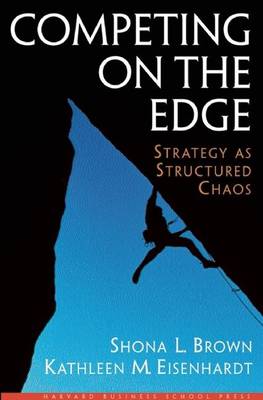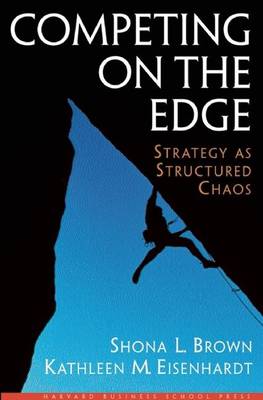
Door een staking bij bpost kan je online bestelling op dit moment iets langer onderweg zijn dan voorzien. Dringend iets nodig? Onze winkels ontvangen jou met open armen!
- Afhalen na 1 uur in een winkel met voorraad
- Gratis thuislevering in België vanaf € 30
- Ruim aanbod met 7 miljoen producten
Door een staking bij bpost kan je online bestelling op dit moment iets langer onderweg zijn dan voorzien. Dringend iets nodig? Onze winkels ontvangen jou met open armen!
- Afhalen na 1 uur in een winkel met voorraad
- Gratis thuislevering in België vanaf € 30
- Ruim aanbod met 7 miljoen producten
Zoeken
Competing on the Edge
Strategy as Structured Chaos
Shona L Brown, Kathleen M Eisenhardt
Hardcover | Engels
€ 40,45
+ 80 punten
Omschrijving
Unstable markets, fierce competition, and relentless change are the only certainties in today's chaotic business world. In their startling new book, authors Brown and Eisenhardt contend that to prosper in such volatile conditions, standard survival strategies must be tossed aside in favor of a revolutionary new paradigm--competing on the edge. To compete on the edge is to relentlessly reinvent, and it's the only way to navigate the treacherous waters of tumultuous markets. Competing on the edge is an unpredictable, sometimes even inefficient strategy, yet a singularly effective one in an era driven by change. It requires charting a course along the edge of chaos, where a delicate compromise is struck between anarchy and order, to the edge of time, where current business is the primary focus, but actions are shaped by past legacies and future opportunities. By adroitly maneuvering through chaos and time, managers can avoid constantly reacting to nonstop change and instead set a rhythmic pace that others must follow, thereby shaping the competitive landscape--and their own destiny. In the first book to translate leading edge concepts from complexity theory into management practice, each chapter focuses on a specific management dilemma and illustrates a solution. Linking where do you want to go? With how will you get there? Here's a bold and surprising strategy that works--when the name of the game is change.
Specificaties
Betrokkenen
- Auteur(s):
- Uitgeverij:
Inhoud
- Aantal bladzijden:
- 297
- Taal:
- Engels
Eigenschappen
- Productcode (EAN):
- 9780875847542
- Verschijningsdatum:
- 20/05/1998
- Uitvoering:
- Hardcover
- Formaat:
- Genaaid
- Afmetingen:
- 165 mm x 242 mm
- Gewicht:
- 639 g

Alleen bij Standaard Boekhandel
+ 80 punten op je klantenkaart van Standaard Boekhandel
Beoordelingen
We publiceren alleen reviews die voldoen aan de voorwaarden voor reviews. Bekijk onze voorwaarden voor reviews.











